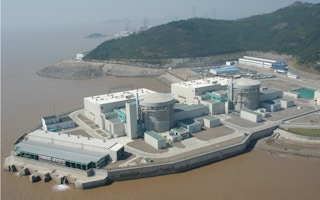In Paris, in early December, the advocates of nuclear power made yet another appeal to world leaders to adopt their technology as central to saving the planet from dangerous climate change.
Yet analysis of the plans of 195 governments that signed up to the Paris Agreement, each with their own individual schemes on how to reduce national carbon emissions, show that nearly all of them exclude nuclear power.
Only a few big players – China, Russia, India, South Korea and the United Kingdom – still want an extensive programme of new–build reactors.
To try to understand why this is so the US-based Bulletin of the Atomic Scientists asked eight experts in the field to look at the future of nuclear power in the context of climate change.
One believed that large-scale new-build nuclear power “could and should” be used to combat climate change, and another thought nuclear could play a role, although a small one. The rest thought new nuclear stations were too expensive, too slow to construct and had too many inherent disadvantages to compete with renewables.
Industry in distress
Amory Lovins, co-founder and chief scientist of the Rocky Mountain Institute, produced a devastating analysis saying that the slow-motion decline of the nuclear industry was simply down to the lack of a business case.
The average nuclear reactor, he wrote, was now 29 years old and the percentage of global electricity generated continued to fall from a peak of 17.6 per cent in 1996 to 10.8 per cent in 2014. “Financial distress stalks the industry”, he wrote.
Lovins says nuclear power now costs several times more than wind or solar energy and is so far behind in cost and building time that it could never catch up.
“
The evidence so far suggests that this is a false hope, one that is best abandoned if we are to deal with climate change with the seriousness the problem demands.
M.V. Ramana, of the Nuclear Futures Laboratory and the Program on Science and Global Security at Princeton University
The full details of what he and other experts said are on the Bulletin’s site, with some of their comments below.
Professor Jeff Terry, of the physics department at Illinois Institute of Technology, was the greatest enthusiast for new nuclear build: “Nuclear energy is a reliable, low carbon dioxide source of electricity that can and should be used to combat climate change.
“China, India, Russia, and South Korea are all building nuclear plants both at home and in other countries. Therefore, nuclear energy will continue to play a role in mitigating the effects of climate change for the next 80 years.
Too slow
“Why are these countries turning to nuclear energy? Mainly due to the versatility and stability of nuclear generation. Nuclear power has the highest capacity factor of any low carbon dioxide-emitting power source.”
Another potential enthusiast was Seth Grae, president and CEO of the Lightbridge Corporation, who believes light water nuclear reactors “must increase globally” if the world is to reach the goals of the Paris Agreement.
However, new technologies that could have a major impact on decarbonising global electricity generation, including advances such as grid-level electricity storage, more efficient wind turbines and new types of nuclear reactors, are not being developed fast enough, he argues.
”Unfortunately, these technologies are not economically competitive enough for utilities to deploy at a large enough scale to prevent catastrophic climate change”, Grae writes. ”Sufficient improvement in economic competitiveness might not be achieved in time to prevent the worst effects of climate change.”
M.V. Ramana, of the Nuclear Futures Laboratory and the Program on Science and Global Security at Princeton University, was dismissive. “There are still some who hope that nuclear power will magically undergo a massive expansion within a relatively short period of time.
”The evidence so far suggests that this is a false hope, one that is best abandoned if we are to deal with climate change with the seriousness the problem demands.”
Peter Bradford, adjunct professor at Vermont Law School, and former Nuclear Regulatory Commission member, agreed: “Climate change, so urgent and so seemingly intractable, has become the last refuge of nuclear charlatans throughout the Western world.”
He said James Hansen, perhaps the most visible of the climate scientists who advocate heavy reliance on breeder or other innovative reactor designs, did so without paying any attention to their track record of long and costly failure.
Hui Zhang, physicist and senior research associate at Harvard Kennedy School’s Belfer Center for Science and International Affairs, said China had a big programme to build nuclear power stations. But they currently generated only 1 per cent of the nation’s huge electricity needs, and even if the target of 110 power reactors by 2030 were achieved, they would produce only 5 per cent.
“While a fleet of nuclear reactors with 130 GWe by 2030 would represent a substantial expansion (over four times China’s current capacity of 30 GWe, and more than the current US capacity of about 100 GWe), it would account for only 5 per cent of total energy use in the country and would constitute just one quarter of the non-fossil energy needed.
“In practice, the total energy use will likely be higher than the planned cap, so the share of nuclear power in the overall energy mix would be even less.
“Eventually, nuclear power is important if China is to address concerns about air pollution and climate change, but it is only one piece of a huge puzzle.”

















